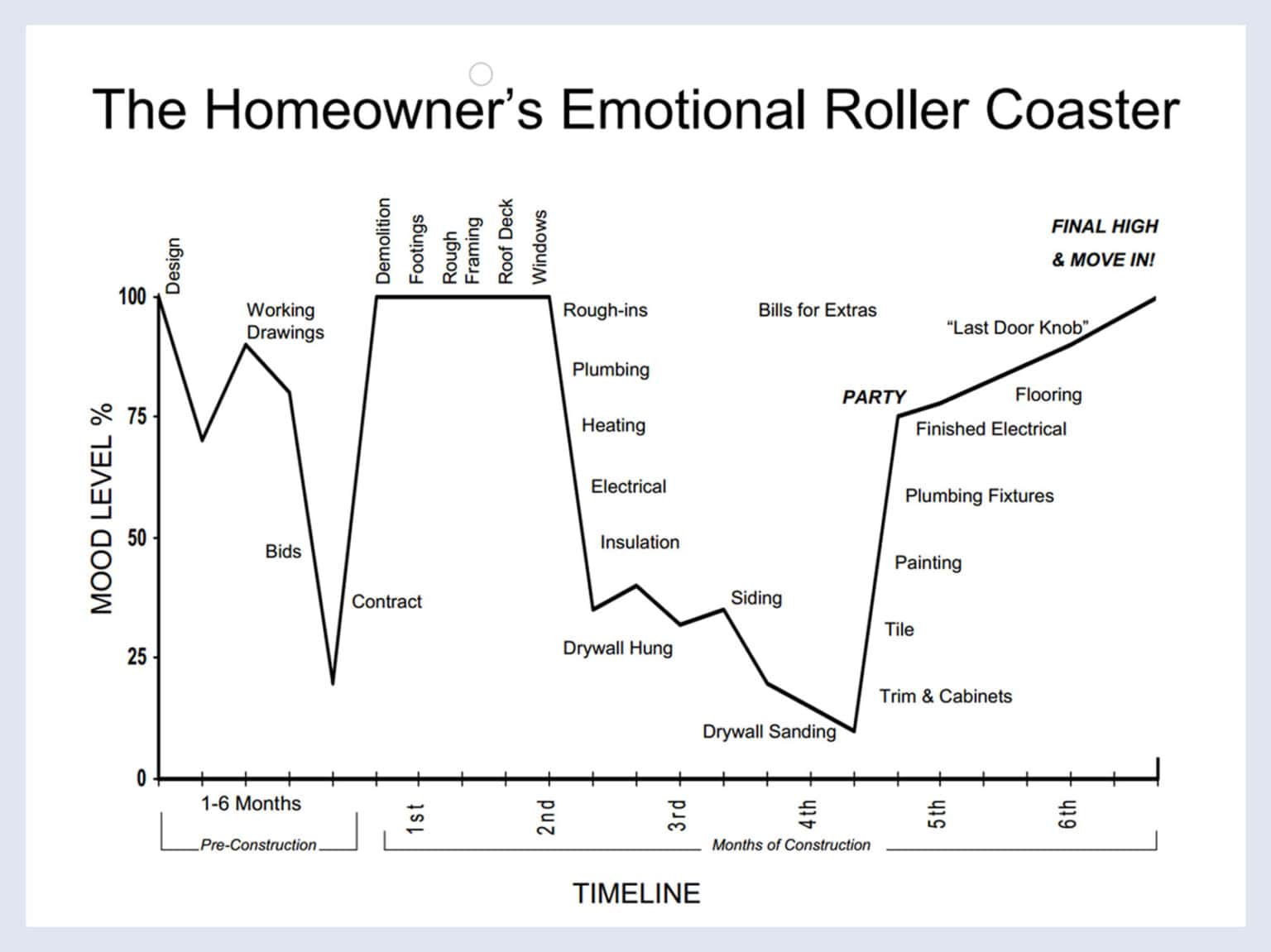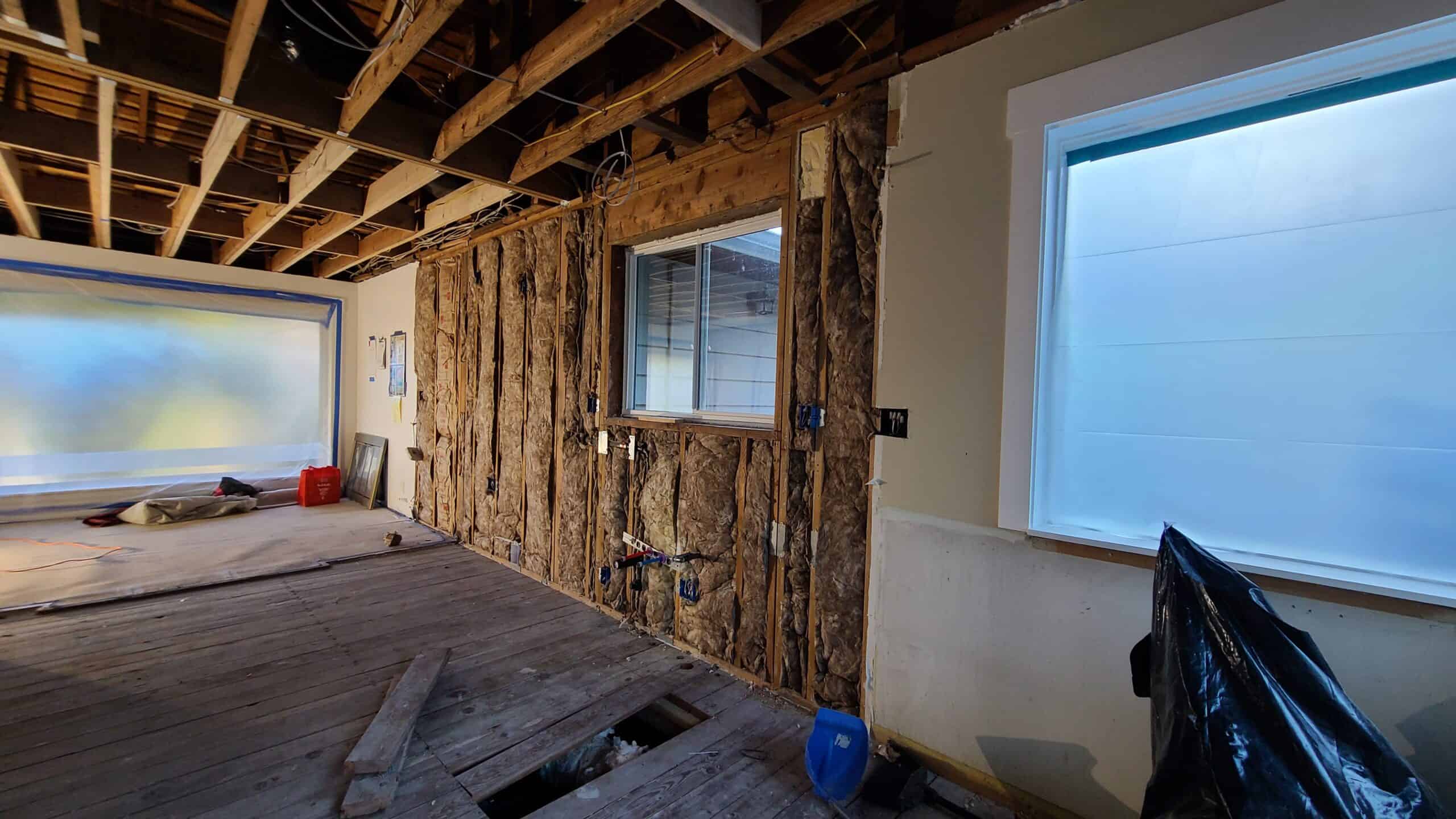
Bathrooms
|Interiors
|Kitchens
Navigating the Emotional Roller Coaster of Home Remodeling
If this is your first time remodeling, it’s completely normal to be feeling a little scared or nervous. This is a big investment and you want to be sure your money is well spent. Just like buying a home, the remodeling process is emotional and full of highs, lows, and expectations. As your trusted team from design through construction, we’ll be here to help you navigate “the remodeling rollercoaster” from beginning to end.
After remodeling homes in the Pacific Northwest for more than 76 years, we know quite a bit about the emotions homeowners go through as they navigate a remodel. Many phases of a project are happy and exciting while others feel unsettling. Neil Kelly Bend Design Consultant Amy Hekker says going through a remodel is a lot like having a baby:
“You get excited about the prospects and what can be.
You worry about it being too much and too costly.
There are good days and bad days, sometimes it even can be physically draining and mentally exhausting.
The process can cause stress and anxiety with your significant other.
It always takes longer than you want and you get antsy towards the end.
The anticipation can be overwhelming at times.
When it’s over you’re are thrilled with the results and so glad it’s over.
At the same time, you can’t imagine going through all that again.
Over time you start to forget about how taxing the process was.
Then a couple of years later…you start thinking of doing it again!”
The best way to take on a remodeling project is by preparing yourself and your family and setting expectations for each phase. Because in the end, it’s worth it! According to the National Association of Realtor’s most recent Remodeling Impact Report, after remodeling, 84% of owners have a greater desire to be in their home, and 86% say that remodeling one area of their home made them want to remodel other areas of their home.
The graph below is shared by many remodeling companies across the country to illustrate the phases of a remodel and how it often feels to go through them. It was originally drawn up by David Lupberger, a nationally recognized speaker, author, and consultant in residential construction.

The Highs and Lows of the Remodeling Process
The design phase is fun. Choosing your cabinets, flooring, tile, and fixtures is exciting and your emotions will be at a high point, especially since your home hasn’t been torn apart yet.
Once you approve your design we reach the agreement, or contract. We try to make it as straightforward and painless as possible, but signing on the dotted line is decidedly not as much fun, and seeing the total cost is a low point for most. This is especially true if you need to concede a few extras to stay within your budget. The benefit of working with a design/build remodeler is that your designer is much more likely to provide you with realistic cost estimates as they design, and then your designer and project manager will work together to keep an eye on your bottom line as the project progresses.
After the agreement, your team will begin purchasing/ordering the specified products and materials, obtaining permits, and scheduling subcontractors for various trades. It’s a busy and complex phase for us, but for many homeowners, it can feel like “the calm before the storm.” If you’re planning to live in your home while it’s being remodeled, this is a great time to prepare yourself and your family for temporary living. For example, if your kitchen is being remodeled, you will want to set up a temporary kitchen in another space in your home with your microwave, coffee maker, and other essentials to get you by.
The next phase is the deconstruction of your existing space. Removing your tired cabinets and outdated fixtures will probably feel like a weight is being lifted off your shoulders. For some homeowners, though, saying goodbye to a part of your home that holds so many memories can be surprisingly emotional. Either way, seeing the empty space once deconstruction is complete might be the first time you can really picture something new there, and that’s an exciting moment.

What comes next can be the hardest part of a remodel and it’s not included in the mood level vs timeline rollercoaster graph above. During deconstruction, we may discover an issue that could increase costs and/or delay your project’s schedule. Things like rot, termites, foundation issues, and other unexpected problems will need to be addressed before we can start construction. There are many other moving targets like subcontractors and shipping schedules that can sometimes cause delays. It’s likely that your Project Manager is prepared for this and has built a contingency for brief delays into your schedule, but sometimes these things take longer than expected. At this point, the best thing you can do is put your trust in your team. Know that they are doing the best they can to put the right parts in the hands of plumbers and electricians at the right time, and they’ll communicate with you every step of the way. With any luck, you’ll sail through this phase without many problems and carry on to construction without worry.
Framing is an exciting part of the remodeling process because you can actually see the bones of your new space beginning to form. But after the framing and the windows go in, you’ll notice the graph shows a steep decline. This phase is where our trusted subcontractors come in to perform the plumbing, HVAC, and electrical updates, which can be complex and take longer than you might expect. While the “rough-ins” are taking place, many homeowners grow tired of seeing the bare bones.
Neil Kelly Eugene Design Consultant Kathy Hanson says, “I check in at the low point of construction for a sit down with the client just to give them a chance to express their very valid feelings in the moment. I want them to be heard when it’s at the hardest point for them in the construction phase. It’s a opportunity for the client to vent in a way they may feel more comfortable than taking it up with the PM or carpenters.”

Thankfully, putting up drywall is the next step, which will improve your mood dramatically. And, once the drywall is hung and sanded, your home will finally begin to take shape again. All of the beautiful things you selected during the design phase will be installed. The brand-new cabinets, the sleek countertops, the glossy tile, and the fancy hardware. It’s all uphill from here. After making it through some low points, you’re finally on that high you’ve been waiting for and you get to see your vision come to life a little more each day

Moving back into your new space will feel like all the lows were 100 percent worth it. Like so many other life changes, we often look back and appreciate the challenging parts because they made us grow. As your remodeling team, it’s our job to help prepare you for those moments and to be a constant and reliable source of reassurance. We hope that knowing the emotional rollercoaster most homeowners go through will help you through your own project.
Ready for the ride? Talk to a Neil Kelly Design Consultant about your home remodeling plans. Schedule a complimentary consultation today.